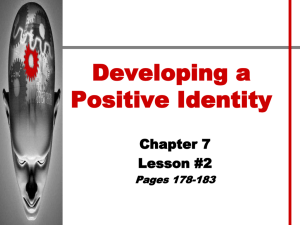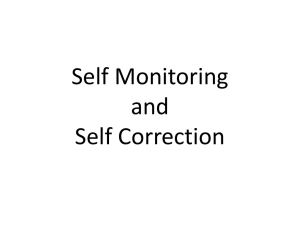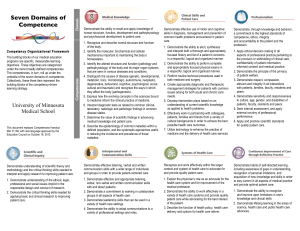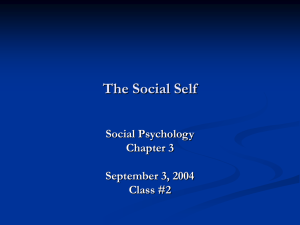Physical Activity and the Self
advertisement
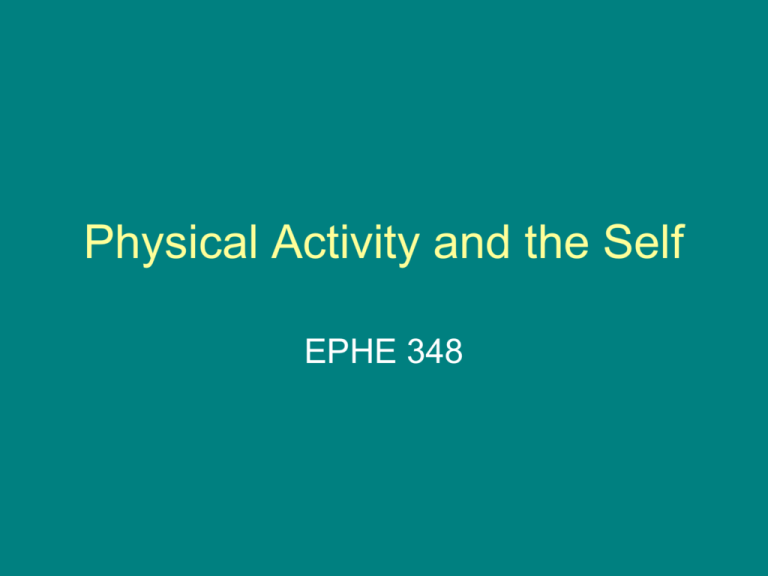
Physical Activity and the Self EPHE 348 Structure of the Self • Self is a complex multidimensional issue • We are both descriptive and evaluative The Self • Self-esteem – evaluation of self in a positive or negative frame • Self-concept – descriptive attributes of the self Importance of the Self (Diener, 1984) • Key indicator of emotional stability • Closely allied to happiness • Linked to independence, leadership, success • Beyond basic needs, the search for selfesteem is probably the most powerful of human motivating forces (Fox, 2000) Structure of the Self • Top self-esteem • Below – multiple facets of self • All aspects of the self influence esteem • Harter (1982)– people need at least one strong facet of the self for high self-esteem (physical, cognitive, social, behavioral) Self Esteem Physical Self-Esteem Sport Competence Physical Strength Physical Condition Body Image Soccer Competence Upper Body Strength Mile Run Social Physique Anxiety Scoring Ability Arm Strength Aerobic Capacity Feeling of Fatness Shooting Self-Efficacy Forearm Curls Efficacy for Pace Total Weight Figure 5.2 Physical Self • Of key importance because it represents our interface with the physical world • Critical in self-rating because of communication and sexuality Measures • General SE scales (e.g., Rosenberg) • Specific Domain scales (e.g. Harter, Marsh, Fox & Corbin) – Physical Self Perception Profile – Perceived Competence Scale – Physical Self-Description Scale • Highly specific measures (body type, physical self-efficacy) PA & Self-Esteem • Over 100 studies and several reviews • Research began in early 70s and continues at about 1-2 RCTs per year Fox, 2000 • Exercise can be used to increase physical self-worth and related constructs (78% of studies significant) • Self-esteem changed in less than 50% • Positive changes in all ages and by men & women • Effects are better for those low in SE Spence et al. 2005 • 113 SE studies in meta-analysis • Overall effect d = .23 • Program, SE level, age, sex, population, health status, measures, type of control group, exercise mode did not matter • Difference from change in fitness Research Focus • Examined the effect of a multiple school-based physical activity program on perceived competencies across five measurement periods totaling 15 months • Participants were 344 nine to eleven year-olds who completed Harter’s perceived competence scale for children. • School-time physical activity was measured using physical activity log-books. Schools interested in participating were randomized to experimental and control conditions (total = 10 schools) Research Focus Cont.. • Repeated Measures Analyses of Variance suggested a significant time x condition effect for school physical activity in favor of the experimental condition (p < .05). • A significant time effect was found for athletic competence, social competence, academic competence, and general selfesteem. Specifically, perceived competencies decreased across the 15 months of the trial. • The condition x time interaction was not significant (p > .05) for any of the competency outcomes. Results were invariant of age, gender, race, and prior physical activity status. Research Focus Cont… • These data suggest that the program was successful in increasing school-time physical activity, but did not affect competencies. • Indeed, participants became increasingly critical of their perceived self as they approached early adolescence. • Rhodes, R.E. & McKay, H.A. (2004). SELF-ESTEEM AND COMPETENCY OUTCOMES AMONG 4TH TO 6TH GRADE STUDENTS ACROSS 15 MONTHS. Annals of Behavioral Medicine, 29, S067. Research Focus (mazzoni et al. in press) • Exploring the effect of a 12 week rock climbing experience on children with special needs • Participants randomized to condition or weight list control • Differences in climbing efficacy were significant (across time and group) but not differences in self-esteem and competencies PA & Body Image • A major issue in the SE / PA relationship • Body image – the self-perceptions an individual holds with respect to his or her body and physical appearance • Women have greater body dissatisfaction than men and the rates for both genders are continually increasing PA & Body image • In general, PA is associated with more body satisfaction • The % of dissatisfied is still staggeringly high – 2/3 of males – 9/10 of females PA & Self-Presentation Concerns • Defn – attempts to present / omit certain aspects of self • Social physique anxiety – degree of body presentation discomfort • SPA – influences exercise motives, participation • SPA – can be reduced by large groups of those similar and increasing familiarity with PA Research Focus • The purpose of the study was to examine the effects of a health-based versus appearance-based persuasive message on exercise attitudes and intentions and to determine if these effects were moderated by the personality trait of self-monitoring • 207 undergraduate students completed the selfmonitoring questionnaire and read either persuasive messages of physical appearance advantages or health benefits of exercise before completing measures of exercise attitude and intention. Research Focus • The results of this 2(self-monitoring) X 2(message-type) MANOVA on the dependent variables of attitude and intention was significant (p<.05). • Follow-up univariate F-tests revealed the attitude interaction as the significant effect (p = <.05). • Post-hoc analysis found low self-monitoring individuals responded with significantly higher attitude scores from exposure to the healthbased message than the appearance-based message. As well, the health-based message produced significantly higher attitude scores among low self-monitors than high. • Rhodes, R.E. & Courneya, K.S. (2000). Effects of a health-based versus appearance-based persuasive message on attitudes towards exercise: Testing the moderating role of self-monitoring. Journal of Social Behavior and Personality, 15, 321-330. Research Focus 7 A t t i t u d e 6.8 6.6 6.4 6.2 -Appearance Based Message 6 5.8 5.6 Health-Based Message 5.4 5.2 5 Low Self-Monitoring High Self-Monitoring






